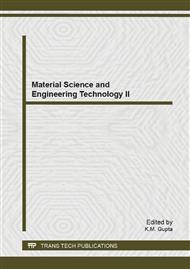p.262
p.267
p.275
p.280
p.285
p.290
p.294
p.299
p.304
Sol Gel Characterization of Nano Kaolin
Abstract:
Nano kaolin is product from kaolin also known as white clay. Kaolin was established as supplementary cementitious materials in concrete. The inclusion of kaolin in concrete enhances strength and durability properties and prolongs concrete life span. In this research, nanokaolin will be develop by using sol gel technique by that involves high energy milling. The process of milling been influenced by time of milling, ball and jar type. Ceramic type Zirconia (Zi) is been used as jar and ball type in this process. Time of milling was set from four (4) hours and one (1) days. Sample will be analyse by using particle size analyser to see the particle size and surface area of kaolin. From the result shows the optimum milling period for nanokaolin is one day base on particle size compare to 4 hours. Furthermore, one day milling produces a massive increment of surface area compare to others. In conclusion, one day can be considered as the optimum cycle time in the production of nano kaolin.
Info:
Periodical:
Pages:
285-289
Citation:
Online since:
December 2013
Authors:
Keywords:
Price:
Сopyright:
© 2014 Trans Tech Publications Ltd. All Rights Reserved
Share:
Citation:


